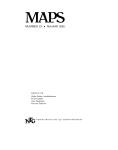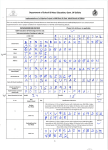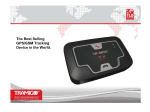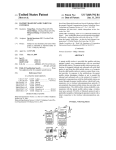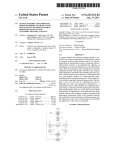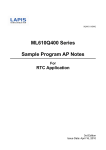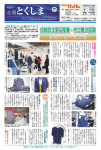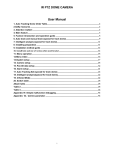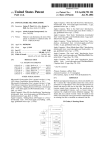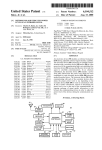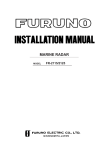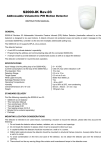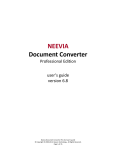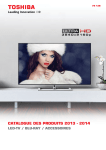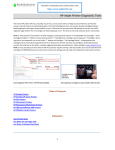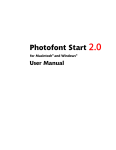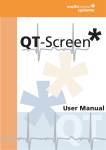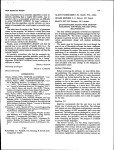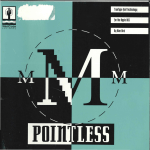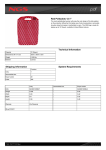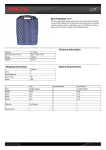Download Method and system for typesetting with multiple
Transcript
US008207984B2 (12) United States Patent (10) Patent N0.: (45) Date of Patent: Kuhns (54) METHOD AND SYSTEM FOR TYPESETTING Michael Doret. The PoWerStation Font Family User Manual and Guide for 2 Color Typesetting. Jun. 2007. p. 3. Alphabet Soup Type Matthew John Kuhns, Lakewood, OH (Us) Notice: Subject to any disclaimer, the term of this patent is extended or adjusted under 35 <http://michaeldoret.com/ “The LTR Federal Manual.” LettError. Oct. 7, 2008. <http://WWW. letterror.com/catalog/fed/manual.html>. astype type foundry. Oct. 7, 2008. <http://WWW.astype.de/s/speci men/SattlerASiWeb.PDF>. “Sauna, a typeface for all sizes” Underware. Oct. 7, 2008. <http:// WWWunderWare .nl/ site2/ index .php?idl :sauna&id2: cfusion/knoWledgebase/index.cfm?id:328509>. “Bitmap fonts: Flavors of Bitmap Fonts.” Sep. 3, 2007. Linotype GmbH. Oct. 7, 2008. <http://WWW.linotype.com/27l2-l5370/ Prior Publication Data US 2010/0013835 A1 (52) (58) CA. detailsdingbats>. Jul. 21, 2008 (65) Hollywood, AlphabetSoup/PoWerStaiManual .pdf>. “PostScript Type 1 and Type 3 Fonts General Information” Jan. 4, 2007. Adobe Systems Inc. Oct. 7, 2008. <http://WWW.adobe.com/ (21) Appl.No.: 12/218,791 (22) Filed: Founders. Andreas Seidel.“Sattler AS Specimen Web Version.” Mar. 17, 2005. U.S.C. l54(b) by 1009 days. (51) Jun. 26, 2012 WITH MULTIPLE-COLOR CHARACTERS USING LAYER FONTS (76) Inventor: (*) US 8,207,984 B2 ?avorsotbitmapfonts.html>. “Font Formats, File Types and Q&A.” Adobe Systems Inc. Oct. 7, 2008. <http://WWW.adobe.com/devnet/opentype/archives/fontifor Jan. 21, 2010 mats.html>. Int. Cl. G09G 5/02 G06F 17/20 “About photofonts: Color Typography” Fontlab Ltd. Oct. 7, 2008. (2006.01) (2006.01) <http://WWW.photofont.com/photofont/about/color/>. “About photofonts: Photofonts in print” Fontlab Ltd. Oct. 7, 2008. US. Cl. ....................... .. 345/594; 345/593; 715/269 Field of Classi?cation Search ................ .. 345/593, <http://WWW.photofont.com/photofont/about/print/>. 345/594; 715/269 See application ?le for complete search history. 2005. Quark, Inc. Oct. 7, 2008. <http://WWW.quark.com/service/ (56) “Synchronizing Text Among Layouts (Cross-platform)” Mar. 30, desktop/support/techinfo/viewj sp?faqiid:207>. * cited by examiner References Cited Primary Examiner * Jeffrey ChoW U.S. PATENT DOCUMENTS 6,057,858 A * 5/2000 6,091,505 A 7/2000 Beaman et al. 6,762,770 B1 7/2004 Opstad et al. One embodiment of a desktop publishing system including a 6,867,787 B1 * 6,870,535 B2 * 3/2005 3/2005 typesetting software application, one or more families of 7,006,108 B2 2/2006 Perry et al. 2008/0129755 A1 * 2009/0172524 A1 * 6/2008 7/2009 Desrosiers .................. .. 345/467 Shimizu et al. ............. .. 345/629 Hill et al. .................... .. 345/467 Nakamura .................. .. 345/629 Sorenson .................... .. 715/269 (57) ABSTRACT layer fonts, and a layer font manager program. The layer font manager Will automate the creation of copies of a text object selected Within the typesetting application, and assign to those copies other fonts from the same layer font family as OTHER PUBLICATIONS that of the original object. The layer font manager Will addi Sara Froehlich.“Text Effects in Illustrator CSiMultiple Strokes on tionally bind the original object together With the copies into a composite unit, keeping all copies precisely aligned. This Type” About.com. Oct. 14, 2008. <http://graphicssoft.about.com/ od/illu strator/ss/sfstroketext .htm>. Font Naming Issues. Apr. 12, 1993. pp. 5-l6. Adobe Systems, Inc. San Jose, CA. <http://WWW.adobe.com/devnet/font/pdfs/5088. embodiment Will simplify the process of using layer fonts to set type With multiple-color characters. FontNames.pdf>. 2 Claims, 16 Drawing Sheets 410 q f418 / \ Heavyset Outlined 414 TU Heavyset 50|ld\//-\412 \ij Heavyset Extrudedvf US. Patent Jun. 26, 2012 Sheet 1 0f 16 US 8,207,984 B2 llO \ 118 "\ El E1 n I: 410 © 114 N / //l I l l \ \ \ \ \ \\\‘ x\_'1:16 FIG. 1B 112 llO\ INPUT/ X‘ COMPUTER K_\\ 115 )\ MEMORY OUTPUT OPERATING SYSTEM DEVICES CPU r; \lzo TYPESETTING APPLICATION 114 /\_ KEYBOARD \ \l22 K LAYER FONT MANAGER 1 A A 116 ’\~ MOUSE 118/\E MONITOR < ~ 11 STORAGE MEDIA /' 113 DATABASE \) / 310 FAMILY OF LAYER FONTS \l / 119 \126 US. Patent Jun. 26, 2012 Sheet 3 of 16 FIG. 3 US 8,207,984 B2 /_ 310 DATABASE OF LAYER FONT FAMILIES Bifur Bifur A Bifur B Bifur C Bifur D Bifur E Bifur F Containment Containment Sparkle Containment Solid Containment Shade Containment Full Heavyset Heavyset Polkadots Heavyset Outline Heavyset Solid Heavyset Extruded PowerStation Block PowerStation Block High PowerStation Block PowerStation Block Low Rosewood Rosewood Rosewood Hill 312 US. Patent Jun. 26, 2012 Sheet 5 0f 16 FIG. 5 505 USER SELECTS NEW OBJECT v f“ 510 GET NAME OF FONT APPLIED TO OBJECT SEARCH DATABASE FOR NAME OF FONT 514 NAME PRESENT IN DATABASE? NO— YES GET FAMILY LISTING FROM DATABASE 518 DISPLAY FAMILY LISTING IN PALEI'I'E US 8,207,984 B2 US. Patent Jun. 26, 2012 Sheet 6 6f 16 US 8,207,984 B2 FIG. 6 610 USER ACTIVATES 612 MORE THAN NO I 624 YES SHOW NEWLY i ACTIvATEO FONT UNGROUP SELECTED OBJECT " 614F\ As ACTIVE /\ 626 GROUP ALL COPIEs OF TEXT OBJECT NO v ?szs SELECT NEW COPY FROM GROUP /“620 CREATE COPY IN FRONT OF TEXT OBJECT sET IN NEXT-HIGH EST ACTIVE FONT CREATE COPY BEHIND TEXT OBJECT SET IN NEXT-LOWEST ACTIvE FONT v V ASSIGN NEWLY ACTIVATED FONT TO COPY 630 SHOW NEWLY ACTIVATED FONT As SELECTED FONT ITEM US. Patent Jun. 26, 2012 Sheet 7 0f 16 FIG. 7A FIG. 78 US 8,207,984 B2 US. Patent Jun. 26, 2012 Sheet 8 0f 16 US 8,207,984 B2 FIG. 8 r810 USER ENTERS COMMAND TO DEACTIVATE FONT 812 AT LEAST ONE OTHER ACTIVE FONT? YES NO—— * r814 DELETE TEXT OBJECT WITH DEACTIVATED FONT US. Patent Jun. 26, 2012 Sheet 9 0f 16 US 8,207,984 B2 FIG. 9 910 uSER SELECTS NEw OBJECT IN TYPESEITING APPLICATION 912 IS SELECTICN GROUPED? NO NO YES YES 914 ALL OBJECTS’ X /Y POSITIONS SAME? FONT FOUND IN DATABASE? I, I f 928 SELECT'ON '5 922 FihglfgcLi-llsl'ialsékégR No—. NOT A MANAGED GROUP A 1 F FONTS OF OTHER GROUPED ITEMS A YES 924 916 TEXT OF ALL OBJECTS SAME? N0 YES ‘ f 918 SEARCH DATABASE FOR FONT OF FIRST OBJECT IN GROUP N0 ALL FONTS FOUND IN SAME LISTING? YES 926 ‘ f RECOGNIZE GROUP As A MANAGED GROUP US. Patent Jun. 26, 2012 1010 Sheet 10 0f 16 US 8,207,984 B2 FIG. 10 USER EDITS TEXT OBJECT NO 1013 IS ENTIRE MANAGED GROUP SELECTED? NO 10.1.6 IS NEW PROPERTY A COLOR CHANGE’? NO— YES IS NEW FONT FROM DIFFERENT FAMILY? APPLY EDIT TO ALL OTHER COPIES NO— YES 1022“ I DELETE ALL BUT FRONTMOST SELECTED COPY 10241 ‘V UPDATE MANAGED GROUP AND PALE-‘TE US. Patent Jun. 26, 2012 Sheet 11 0f 16 US 8,207,984 B2 FIG. 11 FONT FROM SAME FAMILY IS ENTIRE MANAGED GROUP SELECTED? NO 1114 IS NEW FONT ALREADY PRESENT IN GROUP? NO ARE YES MULTIPLE ITEMS SELECTED? YES 1126 1122“ I '\ v DELETE ALL BUT FRONTMOST APPLY > NEW FONT TO SELECTED ITEM SELECTED ITEM 1124 A N°—" NEW FONT AS DELETE ALL ACTIVE SELECTED ITEMS ‘I DELETE ALL OTHER SELECTED ITEMS SHOW ABSENT FONTS T AS INACTIVE use/i7 V ‘ , I DONE US. Patent Jun. 26, 2012 Sheet 12 0f 16 FIG. 12 K1210 USER SELECTS FONT ITEM IN PALETTE 1212 IS FONT ITEM CURRENTLY ACTIVE? NO— YES i [-1214 SELECT ASSOCIATED OBJECT FROM GROUP HIGHLIGHT SELECTED FONT AS SELECTED FONT ITEM US 8,207,984 B2 US. Patent Jun. 26, 2012 Sheet 13 or 16 US 8,207,984 B2 FIG. 13 r1310 USER MOVES FONT ITEM IN PALETTE IS MOVED FONT ITEM ACTIVE? NO YES FONT ITEM'S POSITION CHANGED RELATIVE TO ANOTHER ACTIVE FONT NO 1318 I T MOVE TEXT OBJECT WITHIN GROUP TO REFLECT NEW ITEM ORDER REVERT PALETTE ITEMS TO PREVIOUS ORDER US. Patent Jun. 26, 2012 Sheet 14 0f 16 US 8,207,984 B2 FIG. 14 PRESENT IN ANY OBJECT BUT NO ASSIGN FRO NTMOST BORDER TO BACKMOST OBJECT l K1414 REMOVE BORDER FROM ALL OTH ER OBJECTS @ US. Patent Jun. 26, 2012 Sheet 15 0f 16 FIG. 15A 1512 < E/'-\ 1514 US 8,207,984 B2 US. Patent Jun. 26, 2012 Sheet 16 6f 16 US 8,207,984 B2 FIG. 16 1610 USER CLICKS ON BUTTON 1612 IS SELECTION GROUPED? YES —— NO I CREATE COPY 1614 *\ OF TEXT OBJECT FOR EACH mm IN FAMILY 6 DELETE ALL BUT v ASSIGN EACH SELECTED ITEM FROM GROUP FRONTMOST 1616“ FONT IN FAMILY TO ONE COPY IN ORDER LISTED II 1618 1620 GROUP ALL \ COPIES OF TEXT OBJECT DISPLAY SWATCH FOR EACH COPY IN GROUP /“ 1622 US 8,207,984 B2 1 2 METHOD AND SYSTEM FOR TYPESETTING WITH MULTIPLE-COLOR CHARACTERS USING LAYER FONTS characters in one type style. Widely recogniZed fonts include Times Roman, Times Italic, Times Bold and Times Bold Italic, each of Which is a distinct font. Some font ?les may combine a family of multiple related fonts, such as the vari eties of Times, into a single ?le. CROSS-REFERENCE TO RELATED APPLICATIONS Computer fonts are produced by type designers, using special-purpose softWare applications, such as FontLab Stu dio, Fontographer, or FontForge. Type designers’ studios are Not Applicable often referred to as foundries, in a legacy of the metal type of the pre-digital era. STATEMENT REGARDING FEDERALLY SPONSORED RESEARCH OR DEVELOPMENT Computer Font Formats Broadly speaking, font ?les may be classi?ed as bitmap fonts, scalable fonts, or a combination of the tWo. Bitmap fonts describe glyphs as patterns of pixels, or individual squares, Not Applicable Within a grid. Bitmap fonts are mainly employed for display REFERENCE TO SEQUENCE LISTING, A on electronic screens at a ?xed siZe. TABLE, OR A COMPUTER PROGRAM LISTING COMPACT DISC APPENDIX Scalable fonts use mathematical formulas to describe the lines and curves of a glyph. Scalable fonts may be enlarged to any siZe Without losing sharp edges or smooth curves. For this Not Applicable 20 reason, design and printing professionals rely almost exclu sively on scalable fonts for printed text. Examples of com BACKGROUND OF THE INVENTION monly-encountered scalable font formats include Apple Tru 1. Field of the Invention This invention relates to computer typesetting and, more particularly, to the use and management of layer fonts in eType, Type 1, and OpenTypeTM. Nearly all of those font formats Which are Widely sup 25 rendering glyphs With multiple colors. 2. Prior Art The shapes of Written language, at their most basic, are formed of simple strokes or dots. Therefore, characters (let ters, numbers, punctuation, etc.) may be adequately repre sented by glyphs (shapes) of a single color for utilitarian 30 standard fonts. Adobe IllustratorTM, for example, can “?ll” 35 examples of calligraphy. By the 19th century, printers employed “chromatic type” to produce multiple-color letter 40 employed in both printed and electronic media, particularly for consumer-targeted graphics such as signs, packaging and advertising. Most of this lettering, hoWever, must be custom produced for each neW design, because of the monochrome characters With smooth gradations betWeen multiple colors, or With multiple-color patterns. Adobe IllustratorTM and select other applications can also render scalable font char acters With an outline, distinct in color from the character’s interior. ing; different versions of one character Were printed on the same space, using different inks, creating a single composite character of multiple colors. In the modern era, multiple-color lettering is frequently described by bitmaps or mathematical formulas, is a solid shape Which softWare applications use like a rubber stamp. Thus, characters may be assigned any of a variety of colors, but each individual character is alWays rendered With a single, solid color. A feW graphics software applications are capable of pro viding simple enhancements to the monochrome glyphs of purposes. Nevertheless, the use of decorative lettering With multiple colors in individual glyphs is a long-established tradition. Such lettering is present in some of the earliest preserved ported by desktop publishing softWare describe characters as single-color glyphs. Each individual glyph, Whether Generally speaking, hoWever, the “rubber stamp” model prevails for all font formats commonly used in desktop pub lishing. This limits the use of multiple-color lettering to either simple effects (eg gradients, outlines), or else custom letter ing designs Which are laborious and time-consuming to cre 45 ate. paradigm Which generally prevails in computer typesetting. Computer Typesetting Alternative Font Formats Various alternative font formats, introduced or proposed over Typesettingithe process of arranging and styling text for publicationiis today mostly carried out With the use of desk the years, have supported multiple-color glyphs. As Will be seen, hoWever, all such alternative formats possess signi?cant top publishing systems. A typical desktop publishing system 50 softWare. Operating system softWare installed on the com puter, such as Mac OS XTM or WindoWs VistaTM, provides an environment in Which a user may install and run more-spe cialiZed softWare. Professional typesetting softWare may take the form of draWing applications, such as Adobe Illustrators, 55 inherent in the design of the glyphs, preventing their adapta 60 tion to other color schemes. The same limitations of predetermined colors and non scalable bitmap glyphs also apply to the Bitmap Distribution Format (BDF) developed by Adobe Systems Inc., and to the of layouts, typefaces, and typographic effects, and to publish those documents to various printed-output devices or in elec tronic formats. Most computer softWare, including typesetting application softWare, relies on font ?les for rendering text. A font ?le is an electronic document storing descriptions of a set of glyphs; a single font includes glyphs for a complete set of standard in addition to requiring the installation of special softWare, Which is only compatible With a small number of applica tions, Photofonts are bitmap fonts. This generally restricts their usefulness to electronic display at a speci?c, small, siZe. Photofonts are also limited to speci?c color combinations or page layout applications such as Adobe InDesignTM or Quark XPressTM. Desktop publishing systems are Widely used by design professionals and others to compose documents With a variety draWbacks. The PhotofontTM format developed by Fontlab Ltd., Inc., for example, supports glyphs With multiple colors. HoWever, includes a personal computer and specialiZed typesetting 65 format described in US. Pat. No. 6,762,770 (2004) “Method and System for Representation of Color and Other Attributes in Bitmap Fonts”, issued to Beaman and Opstad. The Type 3 speci?cation developed by Adobe Systems Inc., While permitting scalable multiple-color glyphs, shares US 8,207,984 B2 3 4 the PhotofontTM format’s limitation of predetermined color combinations. The Type 3 format is also unsupported by currently-available desktop publishing software, making it by these methods is also labor-intensive, as is editing such text, since both processes result in objects Which are dif?cult to Work With; by relying on characters stacked directly atop impractical for most users and discouraging type foundries from developing neW Type 3 fonts. Another format for a multiple-color font is described in one another, these methods make most components of the composite type dif?cult to access. This in turn hinders experi mentation With different color combinations. US. Pat. No. 6,057,858 (2000) “Multiple Media Fonts”, Existing attempts to solve the problems of layer fonts have been largely unsuccessful. The instructions provided by foundries such as Alphabet Soup, though helpful in explain ing the primary methods for Working With layer fonts, do not issued to Desrosirers. This format, like that described in US. Pat. No. 6,091,505 (2000) “Method and System for Achiev ing Enhanced Glyphs in a Font”, issued to Beaman and Ops tad, describes a font format Which Would permit scalable letters With areas of distinct color in individual glyphs. These formats Would also provide the option for an end user to determine the speci?c values assigned to a glyph’s color variables. No products employing these formats have been made available, hoWever. Adoption of any neW multiple-color, scal able font formats, including those of the aforementioned pat ents, Will furthermore be hindered by substantial obstacles. To be useful, a neW font format Will require type foundries make the actual processes any simpler or more ef?cient. The type foundry underWare has introduced fonts (e.g. Sauna Dingbats) With built-in kerning values, partially auto mating the steps of overlaying each color component used in the second process, but this approach also leaves many prob lems unresolved. Once characters are made to overlap by the second process, it is dif?cult to select one of them, Without ?rst separating 20 them by restoring neutral keming values. Performing this to create, and users to purchase, neW font ?les. A neW font additional step (and reversing it, afterWards) signi?cantly format Will also require development of updates to both com puter typesetting softWare and to the font authoring softWare complicates changes to text, color and font layering order. Further, because this process still requires that a font be used by type designers. Designers and developers face a “chicken-and-egg” dilemma, as the return on creating either applied to nonconsecutive characters, changing the color 25 neW fonts or neW softWare is uncertain, Without the other ?rst being in Widespread use. Further, Whereas the OpenTypeTM format has achieved broad support since its introduction in 1997, it still de?nes glyphs as traditional monochrome shapes. A neW scalable select multiple individual characters throughout the text, then change the color of each, one by one. 30 font format With support for multiple-color glyphs Would introduce a feature unsupported by any current desktop pub lishing softWare. Therefore, such a format Would likely These and other drawbacks of the prior art are overcome, 35 lishing systems. Layer Fonts Type designers, thus largely limited to monochrome font formats, have nevertheless attempted to develop multiple color typefaces using an alternative approach. In place of BRIEF SUMMARY OF THE INVENTION and additional advantages achieved, by a machine for setting type With multiple-color characters. The machine Will include require much more extensive effort to ensure compatibility With the softWare and hardWare components of desktop pub value assigned to one fonts glyphs throughout an entire text Would be sloW and cumbersome. The user Would need to a personal computer, a typesetting application, at least one family of layer fonts, a database of layer font names organiZed by family, and a program for managing layer fonts. The machine Will facilitate the assembly and use of com posite multiple-color type, using layer fonts. The composite 40 type Will be formed of multiple, single-color text objects single multiple-color fonts, type designers have released stacked atop one another. Each object, set in a different font families of “layer fonts” (sometimes referred to as chromatic, from a single layer font family, Will contribute the shapes bicolor or multiple layer fonts). Examples of layer font fami lies include Adobe Systems Inc’s RoseWoodTM, International Which comprise one color variable. House of Fonts’ Bifur, and astype’s SattlerTM. Layer font families consist of multiple individual fonts, 45 the layer font manager Will display a palette listing all fonts in the relevant layer font’s family. A user may then activate another font listed in the palette, prompting the layer font each of Which contains the shapes for one distinct color vari able. Used in concert, fonts from such a family simulate a composite multiple-color typeface. Layer fonts rely on an end user, Who must manually When a text object is selected Within the typesetting appli cation, and is set in a font named in the database of layer fonts, manager to create a neW object, copied from the selected text 50 assemble the component color variables into composite mul but set in the activated font. The layer font manager Will assemble the copy and the original text into a composite, tiple-color type. Many type foundries include illustrated instructions With layer fonts; usually, these instructions guide managed group. the user through one of tWo processes. In the ?rst process, the user must assign a font to one line of Which fonts are represented in the group, as Well as display the When such a group is selected, the palette Will indicate multiple consecutive times, then assign a different font to text color of each object next to that object’s respective font. The layer font manager Will maintain consistency in the text and typographic settings, excepting font or color, of all text objects Within a managed group. By selecting one active font from the palette list While Working With a managed group, the user Will prompt the layer font manager to select only the text assigned that font. By this each instance of the character, and adjust spacing (kerning) means the user Will be able to select, and then assign different betWeen the letters so that characters overlap. nonintuitive, involving many extra steps not normally per color values to, any part of a composite text regardless of Where the component text object is Within the group. The layer font manager Will also permit the user to reorder items Within a managed group, by moving the respective font names formed in computer typesetting. Creating multiple-color text Within the palette. 55 text, then copy that text, paste it directly atop the original, and assign to the neW copy another font from the relevant family. The user must then repeat the process for each color variable included in the family. In the second process, the user must enter a single character 60 Limitations of Layer Fonts Both of these methods have several draWbacks. They are 65 US 8,207,984 B2 6 5 The layer font manager Will, additionally, keep decorative FIG. 15B is an expanded user interface for displaying properties Which may be assigned to a text object, such as information about, and manipulating, text objects set in layer fonts intended for the creation of composite type With mul backgrounds or borders, applied to a single object at the bottom of a managed group, regardless of hoW items may be tiple-color characters. added to, deleted from, or reordered Within the group. FIG. 16 is a How diagram illustrating a process of auto matically assembling, or disassembling, a unit of composite type With multiple-color characters. The machine Will, through these features, provide a system for setting and managing multiple-color type Which is intui tive, user-friendly and ef?cient, and Which furthermore pre serves compatibility With existing layer fonts and other soft GLOSSARY Ware. (Adapted from http://WWW.linotype.com/47/fontglossa ry.html and other sources) BRIEF DESCRIPTION OF THE SEVERAL VIEWS OF THE DRAWING Alphabet: All letters of a language. The English language alphabet has 26 letters. Bitmap: A pattern of elements (eg pixels on a computer FIG. 1A shoWs, in pictorial form, a desktop publishing system Which forms part of an apparatus for setting type With screen) Which make up a character, graphic element, or individual characters of more than one color. image. FIG. 1B is a block diagram illustrating an apparatus for setting type With individual characters of more than one color. 20 Character: The smallest component of a Written language Which has semantic value. A character is the abstract idea FIG. 2 illustrates, in pictorial form, a family of layer fonts intended for the creation of composite type With multiple of the letter, numeral, symbol, etc.; a glyph is the speci?c color characters. FIG. 3 is a diagram illustrating listings Within a database of Chromatic type: Decorative metal or Wood type from the layer fonts organiZed by font family. shape, the form that you see on the page, screen, etc. second half of the 19th century. According to RingWalt’s 25 American Encyclopedia of Printing and Bookbinding (1871): “type made of metal or Wood for color printing and so arranged that there are duplicate or triplicate copies of FIG. 4 is a user interface for displaying information about, and manipulating, text objects set in layer fonts intended for the creation of compo site type With multiple-color characters. each letter, Which, after being printed, respectively, in dif FIG. 5 is a How diagram illustrating a process of determin ing When to display a listing of all fonts from the family of a ferent colors, on a given space, blend together in a harmo nious Whole” Font: Traditionally, a complete set of characters for one type 30 currently selected font. FIG. 6 is a How diagram illustrating a process of creating a copy of a text object, and assigning to it a related font, for the purpose of creating or adding to a unit of composite type With multiple-color characters. FIG. 7A illustrates, in pictorial form, objects forming a unit of composite type With multiple-color characters, in exploded face at one particular type size. In the following speci?ca tion used, per familiar contemporary usage, as a synonym for “type style” 35 ?le, including the character set and the digital instructions contained in the font, such as the keming values, hinting information, and type style name as Well as other control information. vieW. FIG. 7B illustrates, inpictorial form, objects forming a unit of composite type With multiple-color characters, as normally Font File: The technical transfer of a type style into a digital 40 Font Family: Variants of different type styles, collectively combined under ajoint family name. With a font family, individual type styles may vary in stroke Width (e.g., Hel seen by a user. FIG. 8 is a How diagram illustrating a process of deleting a vetica Roman, Bold, Black), slope (e.g., Helvetica Italic), text object from a unit of composite type With multiple-color Width (e.g., Helvetica Condensed, Extended) embellish characters. FIG. 9 is a How diagram illustrating a process of recogniZ 45 ing a unit of composite type With multiple-color characters. FIG. 10 is a How diagram illustrating a process of main taining consistent text and typographic settings among com ponents of a unit of composite type With multiple-color char roman ‘a’, an italic ‘a’ and a small caps ‘A’ are three 50 acters. FIG. 11 is a How diagram illustrating a process of revising a unit of composite type With multiple-color characters When different fonts, from Within the font family used in the com posite type, are applied to part or all of the composite unit. FIG. 12 is a How diagram illustrating a process of selecting a speci?c text object from a unit of composite type based upon user input. FIG. 13 is a How diagram illustrating a process of deter mining Whether or not to reorder text objects Within a unit of improve letter ?t. Traditionally, keming characters Were 55 those Which overhung their oWn Width: in many typefaces, the Roman “f” has a kern to the right, the Roman “j” a kern to the left. Layer Font: A type style designed for use With one or more other type styles from the same family to create text With individual characters Which contain multiple colors. Layer 60 fonts are effectively an electronic successor to Chromatic type. Each type style in a layer font family provides the shapes for one color variable; duplicate copies of a text, FIG. 14 is a How diagram illustrating a process of manag ing a decorative border property Within a unit of composite type With multiple-color characters. FIG. 15A is a user interface permitting the automated different glyphs representing the same character. Keming: Manual or automatic regulation of the spacing betWeen tWo adjacent characters in a text, in order to composite type With multiple-color characters. assembly of composite type With multiple-color characters, using multiple text objects. ment (e. g., Helvetica Rounded), etc., yet have some under lying common design forrn that alloWs for a harmonious appearance When the type styles are used together. Glyph: The shape of a Written character. For example, a 65 each set in a different type style from the layer font family and assigned a unique color, are overlaid directly atop one another to create composite multiple color text. Pixel: Acronym for picture element. The smallest element in a raster image Which can be turned on (printed) or off (not

























